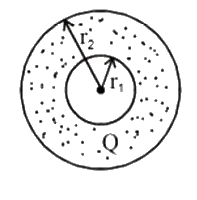A particle is projected from the surface of earth of mass M and radius R with speed . Suppose it travels a distance when its speed becomes to and when speed changes from to 0. Similarly, the corresponding times are suppose . Then
The correct Answer is:
Given,
When speed become to
and
Similarly,
and
Clearly .
Topper's Solved these Questions
- GRAVITATIONBook:DC PANDEYChapter:GRAVITATIONExercise:(C) Chapter Exercises
Explore 45 Videos
- GRAVITATIONBook:DC PANDEYChapter:GRAVITATIONExercise:(A) Chapter Exercises
Explore 68 Videos
- GENERAL PHYSICSBook:DC PANDEYChapter:GENERAL PHYSICSExercise:INTEGER_TYPE
Explore 2 Videos
- KINEMATICSBook:DC PANDEYChapter:KINEMATICSExercise:INTEGER_TYPE
Explore 11 Videos
Similar Questions
Match the column :
A particle at a distance r from the centre of a uniform spherical planet of mass M radius R(<r) has a velocity v magnitude of which is given in column I. Match trajectory from column II about possible nature of orbit.
Column IColumn II(A)0<V<√GMr(P)Straight line(B)√GMr(Q)Circle(C)√2GMr(R)Parabola(D)v>√2GMr(S)Ellipse
View SolutionA charge Q is distributed uniformly within the material of a hollow sphere of inner and outer radii r1 and r2 the electric field at distance x from centre for r1<x<r2 will be :-

View Solution
Knowledge Check
A particle of mass m is projected from the surface of earth with a speed V0(V0< escape velocity). Find the speed of particle at height h=R (radius of earth). (Take, R=6400km and g=9.8m/s2)
A√gRB√v20−2gRC√v20−gRDNone of theseA particle is projected vertically with speed V from the surface of the earth . Maximum height attained by the particle , in term of the radius of earth R,V and g is ( V < escape velocity , g is the acceleration due to gravity on the surface of the earth )
A3RV22gR−2V2B2RV23gR−V2CRV22gR−V2DRV2gR−2V2A simple pendulum has a time period T1 on the surface of earth of radius R. When taken to a height of R above the earth's surface, its time period is T2, ratio T2T is
A1√2B√2C2D4
Two small identical metal balls of radius rare at a distance a (a<<r) from each other and are charged, one with a potential V1 and the other with a potential V2. The charges on the balls are:
View SolutionThe rate of working of an engine is given by
R=15v+6000v, where 0<v<30
and v is the speed of the engine. Show that R is the least when v = 20
View SolutionAn asteroid of mass m is approaching earth, initially at a distance 10RE with speed vi. It hits earth with a speed vf (RE and ME are radius and mass of earth),. Then
View SolutionA body mass 'm' is dropped from heinght R2, from earth's surface, where 'R' is the radius of earth. Its speed when it will hit the earth's surface is (ve=escape velocity from earth's surface).
View SolutionAssuming the earth as an spherical body, for seconds pendulum
Column - IColumn - II(a) at pole(p) T>2s(b) on a satellite(q) T<2s(c) at mountain(r) T = 2s(d) at centre of earth(s) T = 0(t) T>∞
View Solution
